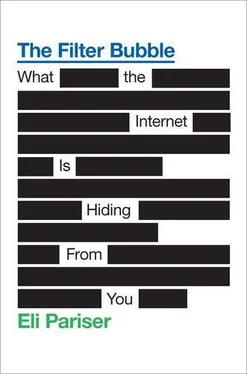Of course, too many options are just as problematic as too few—you can find yourself overwhelmed by the number of options or paralyzed by the paradox of choice. But the basic point remains: The filter bubble doesn’t just reflect your identity. It also illustrates what choices you have. Students who go to Ivy League colleges see targeted advertisements for jobs that students at state schools are never even aware of. The personal feeds of professional scientists might feature articles about contests that amateurs never become aware of. By illustrating some possibilities and blocking out others, the filter bubble has a hand in your decisions. And in turn, it shapes who you become.
The way that personalization shapes identity is still becoming clear—especially because most of us still spend more time consuming broadcast media than personalized content streams. But by looking at how the major filterers think about identity, it’s becoming possible to predict what these changes might look like. Personalization requires a theory of what makes a person—of what bits of data are most important to determine who someone is—and the major players on the Web have quite different ways of approaching the problem.
Google’s filtering systems, for example, rely heavily on Web history and what you click on (click signals) to infer what you like and dislike. These clicks often happen in an entirely private context: The assumption is that searches for “intestinal gas” and celebrity gossip Web sites are between you and your browser. You might behave differently if you thought other people were going to see your searches. But it’s that behavior that determines what content you see in Google News, what ads Google displays—what determines, in other words, Google’s theory of you.
The basis for Facebook’s personalization is entirely different. While Facebook undoubtedly tracks clicks, its primary way of thinking about your identity is to look at what you share and with whom you interact. That’s a whole different kettle of data from Google’s: There are plenty of prurient, vain, and embarrassing things we click on that we’d be reluctant to share with all of our friends in a status update. And the reverse is true, too. I’ll cop to sometimes sharing links I’ve barely read—the long investigative piece on the reconstruction of Haiti, the bold political headline—because I like the way it makes me appear to others. The Google self and the Facebook self, in other words, are pretty different people. There’s a big difference between “you are what you click” and “you are what you share.”
Both ways of thinking have their benefits and drawbacks. With Google’s click-based self, the gay teenager who hasn’t come out to his parents can still get a personalized Google News feed with pieces from the broader gay community that affirm that he’s not alone. But by the same token, a self built on clicks will tend to draw us even more toward the items we’re predisposed to look at already—toward our most Pavlovian selves. Your perusal of an article on TMZ.comis filed away, and the next time you’re looking at the news, Brad Pitt’s marriage drama is more likely to flash on to the screen. (If Google didn’t persistently downplay porn, the problem would presumably be far worse.)
Facebook’s share-based self is more aspirational: Facebook takes you more at your word, presenting you as you’d like to be seen by others. Your Facebook self is more of a performance, less of a behaviorist black box, and ultimately it may be more prosocial than the bundle of signals Google tracks. But the Facebook approach has its downsides as well—to the extent that Facebook draws on the more public self, it necessarily has less room for private interests and concerns. The same closeted gay teenager’s information environment on Facebook might diverge more from his real self. The Facebook portrait remains incomplete.
Both are pretty poor representations of who we are, in part because there is no one set of data that describes who we are. “Information about our property, our professions, our purchases, our finances, and our medical history does not tell the whole story,” writes privacy expert Daniel Solove. “We are more than the bits of data we give off as we go about our lives.”
Digital animators and robotics engineers frequently run into a problem known as the uncanny valley . The uncanny valley is the place where something is lifelike but not convincingly alive, and it gives people the creeps. It’s part of why digital animation of real people still hasn’t hit the big screens: When an image looks almost like a real person, but not quite, it’s unsettling on a basic psychological level. We’re now in the uncanny valley of personalization. The doppelgänger selves reflected in our media are a lot like, but not exactly, ourselves. And as we’ll see, there are some important things that are lost in the gap between the data and reality.
To start with, Zuckerberg’s statement that we have “one identity” simply isn’t true. Psychologists have a name for this fallacy: fundamental attribution error. We tend to attribute peoples’ behavior to their inner traits and personality rather than to the situations they’re placed in. Even in situations where the context clearly plays a major role, we find it hard to separate how someone behaves from who she is.
And to a striking degree, our characteristics are fluid. Someone who’s aggressive at work may be a doormat at home. Someone who’s gregarious when happy may be introverted when stressed. Even some of our closest-held traits—our disinclination to do harm, for example—can be shaped by context. Groundbreaking psychologist Stanley Milgram demonstrated this when, in an oft-cited experiment at Yale in the 1960s, he got decent ordinary people to apparently electrocute other subjects when given the nod by a man in a lab coat.
There is a reason that we act this way: The personality traits that serve us well when we’re at dinner with our family might get in the way when we’re in a dispute with a passenger on the train or trying to finish a report at work. The plasticity of the self allows for social situations that would be impossible or intolerable if we always behaved exactly the same way. Advertisers have understood this phenomenon for a long time. In the jargon, it’s called day-parting , and it’s the reason that you don’t hear many beer ads as you’re driving to work in the morning. People have different needs and aspirations at eight A.M. than they do at eight P.M. By the same token, billboards in the nightlife district promote different products than billboards in the residential neighborhoods the same partiers go home to.
On his own Facebook page, Zuckerberg lists “transparency” as one of his top Likes. But there’s a downside to perfect transparency: One of the most important uses of privacy is to manage and maintain the separations and distinctions among our different selves. With only one identity, you lose the nuances that make for a good personalized fit.
Personalization doesn’t capture the balance between your work self and your play self, and it can also mess with the tension between your aspirational and your current self. How we behave is a balancing act between our future and present selves. In the future, we want to be fit, but in the present, we want the candy bar. In the future, we want to be a well-rounded, well-informed intellectual virtuoso, but right now we want to watch Jersey Shore. Behavioral economists call this present bias—the gap between your preferences for your future self and your preferences in the current moment.
The phenomenon explains why there are so many movies in your Netflix queue. When researchers at Harvard and the Analyst Institute looked at people’s movie-rental patterns, they were able to watch as people’s future aspirations played against their current desires. “Should” movies like An Inconvenient Truth or Schindler’s List were often added to the queue, but there they languished while watchers gobbled up “want” movies like Sleepless in Seattle. And when they had to choose three movies to watch instantly, they were less likely to choose “should” movies at all. Apparently there are some movies we’d always rather watch tomorrow.
Читать дальше











